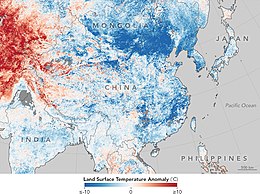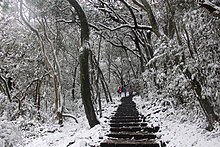January 2016 East Asia cold wave
 Variation from average land surface temperatures between 17–24 January 2016 | |
| Formed | 18 January 2016 |
|---|---|
| Dissipated | 24 January 2016 |
| Lowest temperature | −46.8 °C (−52.2 °F) in Inner Mongolia, Irkutsk Oblast and Zabaykalsky Krai, −19 °C (−2 °F) in Pyongyang (lowest urban temperature) |
| Maximum snowfall or ice accretion | 142 cm (56 in) in Kitahiroshima, Japan |
| Fatalities | At least 109 deaths |
| Areas affected | East Asia, Southeast Asia and South Asia |
In late January 2016, a
Hong Kong
On 24 January, the temperature at the
Classes were cancelled for more than 510,000 students of kindergartens, primary schools, and the English Schools Foundation on 25 January.[9] The closure was suggested by the Hong Kong Professional Teachers' Union and it is believed to have been the first time the Education Bureau has ever cancelled classes due to cold weather.[10] In the face of some criticism the government noted that most schools do not have heaters.[11] The vice chairman of the Aided Primary School Heads' Association stated that the decision was justified as slippery roads could endanger school buses, which in Hong Kong are not fitted with winter tires.[10]
Japan
Snowstorms across
Mainland China
Snow and sleet were reported in parts of Guangzhou, the first time these had been observed since 1967 and 1956 respectively.[12][15] Snow also fell on Shenzhen, a rare occurrence for the region.[3] At least four people died of carbon monoxide poisoning from a heating system in Guangzhou.[12] Farther north, the minimum temperature in Shanghai fell to −7.2 °C (19.0 °F), lowest since 1990,[citation needed] with light snow falling on the morning of 23 January.[citation needed] Twenty-four weather stations observed all-time record lows. Temperatures across Inner Mongolia fell to a record low of −46.8 °C (−52.2 °F).[15][where?]
Korean Peninsula
Snow and cold weather forced the cancellation of 1,200 flights on
Taiwan





A surge of cold air during the weekend of January 22–24 brought temperatures as low as 4 °C (39 °F) to
The cold weather caused severe damage to crops, with losses exceeding NT$20 million (US$600,000) in Miaoli County alone. President Ma Ying-jeou declared the crop damage a national concern.[18]
Vietnam
In Hanoi, Vietnam, the lowest temperature in the downtown recorded was 5 °C (41 °F), the lowest temperature measured in the city in over 20 years. Snowfall was recorded in the mountainous areas of Ba Vì near the capital on January 24.[21]
Snow fell across the mountains of
In
Some other places recorded the first snowfall in their history, most notably the
Rest of Southeast Asia
In
In
In the Batanes islands of the Philippines, temperatures dropped below 10 °C, a record low for the Philippines at sea level. In the mountainous city of Baguio, where tourists typically flock because of the cooler weather, temperatures dropped to 9 °C (48 °F), the city's coldest recorded temperature in 2016.
In Cambodia, temperatures in some parts of the country dropped to 19 °C (66 °F).[citation needed]
In Myanmar, the lowest temperature recorded was −5 °C (23 °F) in Putao. In Yangon, temperatures fell to 14 °C (57 °F).[citation needed]
In Malaysia, temperatures in some parts of the country dropped to between 21 °C (70 °F) and 16 °C (61 °F). The lowest temperature recorded was 14 °C (57 °F) in Keningau, Sabah. In Kundasang, temperatures fell to 10 °C (50 °F).[citation needed]
South Asia
In
In
See also
References
- ^ Wang, S.-Y. S., Y.-H. Lin, M.-Y. Lee, J.-H. Yoon, J. D. D. Meyer, and P. J. Rasch (2017), Accelerated increase in the Arctic tropospheric warming events surpassing stratospheric warming events during winter, Geophys. Res. Lett., 44, doi:10.1002/2017GL073012.
- ^ The Weather of January 2016
- ^ a b c d e f g "East Asia cold snap 'kills 85 in Taiwan'". BBC. 25 January 2016. Retrieved 26 January 2016.
- ^ Leung, Christy (25 January 2016). "Hong Kong frost chasers ridiculed: hospitalisations, arguments with police, 300 firemen and 8 helicopter flights to rescue them". South China Morning Post.
- ^ a b c d Ap, Tiffany (25 January 2016). "Deaths, travel disruption as bitter cold grips Asia". CNN. Retrieved 25 January 2016.
- ^ Lau, Kenneth; Ng, Yupina; Benitez, Mary Ann (26 January 2016). "The cold hard facts". The Standard.
- ^ a b c "Inter-departmental rescue operation conducted at Tai Mo Shan". Hong Kong Government Press Release. Information Services Department. 25 January 2016.
- ^ Grundy, Tom (24 January 2016). "In Pictures: Fire Dept. urges 'frost tourists' to stay home after 85 rescued from HK's highest peak". Hong Kong Free Press.
- ^ Au-yeung, Allen; Lai, Ying-kit (25 January 2016). "Nowhere else to go: Hong Kong working parents take children to school despite cold weather suspension". South China Morning Post.
- ^ a b Lau, Kenneth (25 January 2016). "Big freeze shuts schools". The Standard.
- ^ Cheng, Albert (28 January 2016). "Hong Kong's embarrassingly poor response to cold snap must not be repeated". South China Morning Post.
- ^ a b c d e Withnall, Adam (25 January 2016). "Asia cold snap: Scores dead as freezing 'polar vortex' sweeps across eastern Asia". The Independent. Retrieved 25 January 2016.
- ^ a b "Heavy snow clobbers central, western Japan". The Japan Times. Jiji Press, Kyodo News. 24 January 2016. Retrieved 3 February 2016.
- Asahi Shimbun(in Japanese). 25 January 2016. Retrieved 4 February 2016.
- ^ a b c Holmes, Oliver (25 January 2016). "Deaths in Japan and Taiwan as record cold snap hits east Asia". The Guardian. Retrieved 25 January 2016.
- ^ "Residents of Ulleungdo Island, True Snow Troopers". The Korea Bizwire. Pohang. 27 January 2016. Retrieved 29 January 2016.
- ^ Kim, Kim So; Chou, Choong Il (25 January 2016). "Cold wave hits Korea, strands tourists on Jeju". Korea JoongAng Daily.
- ^ a b "Cold decimates crops, fish farms". The China Post. Taipei, Taiwan. 26 January 2016. Retrieved 26 January 2016.
- ^ "The World Factbook: Taiwan". CIA. Retrieved 31 January 2016.
- ^ Chang, S.C. (26 January 2016). "Only 3 died from low temperatures over weekend: Health Ministry". Focus Taiwan. Central News Agency. Retrieved 27 January 2016.
- ^ "Snow rarely appears in Hanoi". Sài Gòn Giải Phóng. Hanoi, Vietnam. 25 January 2016. Retrieved 25 January 2016.
- ^ "Snowfall draws over 10,000 visitors to Sapa". Nhân Dân. Sa Pa, Vietnam. 25 January 2016. Retrieved 25 January 2016.
- ^ "More northern localities covered by snow". Nhân Dân. Northern, Vietnam. 24 January 2016. Retrieved 24 January 2016.
- ^ "In pictures: Snowfall in central Vietnam for the first time". VietNamNet. North Central, Vietnam. 26 January 2016. Retrieved 26 January 2016.
- ^ "Two die as cold bites in Central region". Bangkok Post. 26 January 2016. Retrieved 31 January 2016.
- ^ "Cold wave causes 14 deaths". Bangkok Post. 27 January 2016. Retrieved 28 January 2016.
- ^ "Northern Lao provinces hit by extreme cold snap". Vientiane Times. Vientiane. 26 January 2016. Retrieved 28 January 2016.
- Channel NewsAsia. Mediacorp. 25 January 2016. Retrieved 3 February 2016.
- ^ "700 schools shut in Rautahat, Parsa due to cold". The Himalayan Times. Rautahat. 27 January 2016. Retrieved 3 February 2016.
